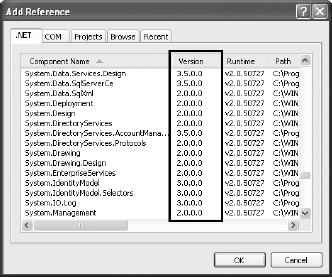Appendix B. Examining the .Net Class Libraries Using the Object Browser
To be successful in .NET programming requires not only that you know the language you are using (C# in this case) but that you be familiar with the classes in the .NET Framework class library. Navigating the huge number of classes in the class library is a daunting task, and it takes a developer many months to get acquainted with the different classes. This appendix summarizes the features of the various versions of the .NET Framework and explains how to use the Object Browser feature in Visual Studio 2008 to browse the available namespaces and classes in the .NET Framework.
Versions of the .NET Framework
The .NET Framework 3.5 builds upon the previous versions of the .NET Framework, namely, version 2.0, 2.0SP1, 3.0, and 3.0SP1. This is evidenced by the set of assembly references available in the Add Reference dialog (see Figure B-1).

Figure B.1. Figure B-1
The assemblies have different version numbers — some are version 2.0, while some are 3.0 and the rest 3.5. That is to say, when you develop a .NET 3.5 application, your application is actually using a combinations of .NET 2.0, 3.0, and 3.5 class libraries.
The assemblies for the different versions of the .NET Framework are located in the following directories on your development machine:
Version 2.0 —
C:\WINDOWS\Microsoft.NET\Framework\v2.0.50727Version 3.0 —
C:\Program ...
Get C# 2008 Programmer's Reference now with the O’Reilly learning platform.
O’Reilly members experience books, live events, courses curated by job role, and more from O’Reilly and nearly 200 top publishers.

